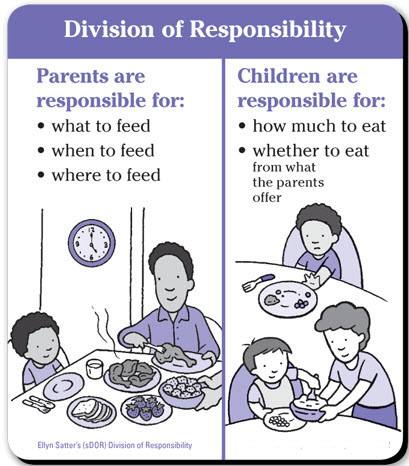Raising good eaters and working towards healthy body weights for children
![kids-healthy-foods[1]](http://weilernutrition.com/wp-content/uploads/kids-healthy-foods1.jpg) One in 10 Canadian children has clinical obesity. The obesity epidemic has all stakeholders looking for answers which to this date seem to elude us. Clearly there is not one magic fix, but there are glimmers of hope in common sense approaches that are promising. Preventing overweight and obesity in children is a particularly high priority public health initiative. As a nutrition professional, but more importantly as a mother of three children I confess having family eating and feeding dilemmas over the years. Upon reflecting on my parenting choices I found thoughtful and actionable advice Ellyn Satter’s work. Ellyn, a fellow registered dietitian provides a unique perspective that advocates a non-restrictive approach to feeding children. It emphasizes good parenting with respect to the provision of food, feeding dynamics and physical activity. The Satter model of “division of responsibility in feeding” is this:
One in 10 Canadian children has clinical obesity. The obesity epidemic has all stakeholders looking for answers which to this date seem to elude us. Clearly there is not one magic fix, but there are glimmers of hope in common sense approaches that are promising. Preventing overweight and obesity in children is a particularly high priority public health initiative. As a nutrition professional, but more importantly as a mother of three children I confess having family eating and feeding dilemmas over the years. Upon reflecting on my parenting choices I found thoughtful and actionable advice Ellyn Satter’s work. Ellyn, a fellow registered dietitian provides a unique perspective that advocates a non-restrictive approach to feeding children. It emphasizes good parenting with respect to the provision of food, feeding dynamics and physical activity. The Satter model of “division of responsibility in feeding” is this:
- Parents are responsible for the what, when and where of feeding
- Children are responsible for the how much and whether of eating

In her book ‘ Your child’s weight, helping withou harming’ Satter’s approach to eating focuses on positive relationships and developing trust in your children to learn to enjoy food in the amounts that will help them grow in health and wellness. The book also advocates for the importance of family meals as a means of providing structure and reassurance of adult support.
Here are some tips on raising good eaters and enjoying mealtimes with your kids:
- Maintain a division of responsibility: Parents provide the what, when, and where of feeding; Children choose how much and whether of eating.
- Provide regular meals and snacks. Children need to know that they will have enough, acceptable food provided to them on a reliable basis. Engage kids and teens in the meal planning discussions.
- Aim for variety and prepare foods in different ways. Be patient and offer children the choice of how much of a new food they will try. Remember sometimes accepting new foods takes time. Demonstrate the enjoyment of the new food yourself, and offer them in different ways, but be matter of fact about how much your child chooses to eat. (Praise can feel like pressure!)
- Aim for pleasant family meals with a food focus, be it at home or when eating out. Research shows that regular family meals make a big difference in the health and wellness of children. So turn off the TV sit together and enjoy at least 5 family meals a week – any meal counts be it a breakfast, lunch or dinner.
- Use non-food/beverage items for rewards. Consider activities, time spent together or stickers instead of food treats.
“Epilogue. When raising children, give it your best effort, find out if it works, then tinker with it.”
– Ellyn Satter is a keynote speaker at the Society for Nutrition Education and Behavior (SNEB) annual conference in June 2015. See more at: http://www.ellynsatterinstitute.org/